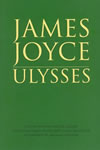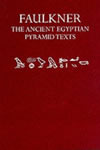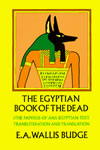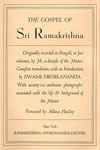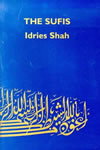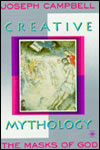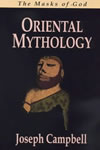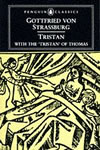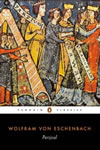The final essay in The Flight of the Wild Gander is The Secularization of the Sacred. Here Campbell deals with how to open ourselves to ‘the wonder of the whole world and oneself within it.’ He begins with Shri Ramakrishna’s realization that ‘everything is Pure Spirit’. Everything from cooking utensils to fellow human beings. Campbell assures us that such an identification with the divine is basic to ‘the entire range of the high religions of the Orient eastward of Iran.’ This is the nirvana of the Buddha, the Tao of Lao Tzu: ‘The ultimate goal of Oriental worship is ... the realization of one’s own identity with this reality and a recognition of its presence in all things — not, as in our Western religions, to worship a god distinct from his creation, of a different order of being — apart — “out there”.’ He then cites the Brihadaranyaka Upanishad from about 700 B.C. which say ‘Whoever thus knows, “I am brahman!” becomes this All; not even the gods have the power to prevent his becoming thus, for he then becomes their Self.’ This Upanishad goes on to explain that anyone who sees divinity as separate from his own being ‘is like a sacrificial animal for the gods’, and of course the gods are pleased to receive sacrifices, so would dissuade their worshippers from realization.
The Book of Genesis shows man expelled from paradise for realizing his godly nature, differentiating good and evil. Campbell compares the Way to the Tree of Life in Eden, to the marga, or path, of the Indian seeker, the Chinese Tao, and the ‘gateless gate’ of Zen. As cherubim with flaming swords guard the gate to Eden, to forbid mankind entry, so temple guardians stand before Buddhist temples, but rather to fend off evil and protect the seeker.
Campbell considers the ultimate reality transcendent of all definition. It becomes absurd to assign qualities such as mercy, justice or wrath to the ground of being, or to suggest that it favours one race of people over another. Although transcendent, this reality, this truth, this support, this energy is immanent in each and every one of us. It can be accessed from any place and through any vehicle, even contemplating a simple object such as a pencil can transport the individual into ‘the incorruptible eon of the gods’, as James Joyce had it.Only by separating away attributes does this connection occur. This is the no-self of Buddhist teaching. The individual realizes that he is not his body, his thoughts, his feelings, his beliefs, his possessions: ‘For we are all, in every particle of our being, precipitations of consciousness’. And that consciousness is ultimately indivisible, as the eminent quantum physicist Erwin Schrödinger said: ‘To divide or multiply consciousness is something meaningless. In all the world, there is no kind of framework within which we can find consciousness in the plural; this is simply something we construct because of the spatio-temporal plurality of individuals but it is a false conception ... This life of yours which you are living is not merely a piece of the entire existence, but is in a certain sense the whole; only this whole is not so constituted that it can be surveyed in one single glance.’ Schrodinger refers to the Hindu formula tat tvam asi — ‘this is you’; or ‘you are It’!
Unlike Yahweh, the Holy Trinity or Allah, the gods of the Orient are not ‘final terms ... but point beyond themselves to that ineffable being, consciousness and rapture that is the All in all of us. And in their worship, the ultimate aim is to effect in the devotee a psychological transfiguration through a shift of his plane of vision from the passing to the enduring, through which he may come finally to realize in experience (not simply as an article of faith) that he is identical with that before which he bows.’
The Egyptian Pyramid Texts, from about 2350-2175 B.C., hint at the same identification where the deceased at death takes back the godly powers lost by having been mortal. A thousand years later The Book of the Dead describes a similar identification between man and the gods. Such ideas trace back to Mesopotamia, to the beginnings of human civilization, where in seals the Lord of the Tree of Life rewards worshippers with either the sap of the tree or its fruit — bestowing upon them the immortality that would be denied by Yahweh to Adam and Eve in Genesis, over two thousand years after that the oldest Sumerian representation. In India, the god Shiva sits at the foot of the Tree, dispensing the same moon elixir of life. Prince Siddhartha achieved Buddhahood ‘at the foot of that same World Tree’.The aim of the Orphic mysteries in the classical Greek world was identity with divinity, through the bounty of the Egyptian goddess Isis. The drink of deathlessness is found also in the German and Celtic myths. The Viking god Odin or Wotan gave an eye for a sip of this elixir at the foot of the World Ash, Yggdrasil. The Celtic sea god Manannan served an ale that gave immortality.
But this almost universal quest for identity with the divine has been pushed aside strenuously by followers of Yahweh who, ‘as we know (arriving very late on the scene), cursed the serpent of the Garden ... and with it the whole earth, which he seems to have thought he had created.’ And in this new religion derivative of the Sumerian, but thousands of years its junior, the world is separated from its creator, no longer symbiotically bound together. The Creator and his Creatures are now of a separate substance and ‘are not to be identified with each other in any way. In fact, an experience of identity is the prime heresy of these systems, punishable by death.’
A slew of exclusive groups proclaim themselves The Chosen of this Hebrew war god. The Jews make a covenant with him through circumcision. The Christians insist that their Messiah is the one and only child of Yahweh. And so with almost all of their many bickering sects, and those of Islam (save for certain Sufis who risk a less exclusive view). Yet Buddhists still say ‘All things are Buddha things’, and Hindus ‘Brahman sleeps in the stone.’
By the Middle Ages, the crucifix had become synonymous with the Tree of Immortal Life, with Christ as its fruit and his blood the ambrosial drink. The Mass became a ‘renewal of the sacrifice on Calvary’.
The scriptures become literal truthes, no longer symbolic of a path to revelation, but doctrines to be repeated and believed absolutely on threat of death. Holiness no longer dwells in the living individual as it does in the traditional religions, but is vested in some ‘completely unique and special fetish’, such as the Ark of the Covenant, the Torah, the Transubstantiated Host, the Bible, the Koran or the Ka’aba. These signposts have been turned to idols that no longer point anywhere, but are seen as destinations in themselves. But as the eighth-century Chinese sage Ma-tsu said, ‘You have your own treasure house, why do you search outside?’. Ramakrishna said ‘brahman alone is real and the world illusory; I have no separate existence; I am that brahman alone.’, but he warns of the danger of revealing this truth to simple people, for whom it is better to see God as the master, and themselves as his servants.The punitive religion that now governs so much of the world allows no other gods ‘Nor is there any allowance, there, for the following of one’s own light: the leadership and guidance of one’s own expanding, deepening, enriched experience of the nature of the world and oneself. All life, all thought, all meditation is to be governed by the authority of the shepherds of the group; and there can be no doubt ... that this authority was maintained by force. But any religious symbol, so interpreted that it refers not to a thought-transcending mystery but to a thought-enveloping social order, misappropriates to the lower principle the values of the higher and so ... sets Satan in the seat of God.’
Campbell questions the irony ‘that a religion of this overbearing kind — exclusive, authoritative, collective and fanatic.’ took over in Europe, and so spread itself about the world; but as he says ‘the graft would appear not to have taken hold.’ After centuries of battling against heresies, the surviving Churches, no longer permitted to burn heretics at the stake, are losing the faithful in droves. Precisely because of the insistence on literal interpretation of metaphorical mythology.
Campbell sees the origins of this decline in the brave decision ‘of an increasing number of people of great stature to credit their own experience and to live by it, against the dictates of authority.’ It has taken many years for the twelfth century revelations of Abelard, and the beliefs of the Troubadours, to set aside the dogmatic brutality of the Church.
Campbell speaks of the distinction between the concept of amor that rose up among the Troubadours. Elsewhere, both Campbell and Idries Shah argue convincingly that the Little Renaissance of the Languedoc carried Sufi ideas from Spain into Christendom (Campbell in Creative Mythology, pp.62-63, Idries Shah in The Sufis). Among Sufis, ‘woman is treated as a vessel or symbol of divine import’. Campbell quotes Coomaraswamy, speaking about the Indian Sahaja group, and the mystic realization of ‘the self-oblivion of earthly lovers locked in each others arms, where “each is both”.’Amor transcends the lust of eros, in Sanskrit kama, which is transformed, followers of Sahaja believe, into prema — divine love — through elimination of the self. It is no surprise that the Albigensian, or Cathar, heresy rose where the Troubadours first penetrated Christian Europe. This sect had parfaits instead of priests; parfaits who could as well be women as men, and who had achieved their status through their experience rather than through training. It is also no surprise that the Albigensians were destroyed with the same ferocity as the earlier rule-disobeying Gnostic sects.
The Troubadour romances, such as that of Tristan, are still bound to the concept of earthly love, unlike the contemporaneous story of Krishna the god and his love for the cowherd Radha. Here the symbolism of the love of spirit and flesh is clear, where the poets who wrote of Tristan and Isolde ‘have represented the lovers as human, all too human — overwhelmed by a daemonic power greater than themselves.’ Campbell points out that from the Troubadours perspective, in the Middle Ages, marriage ‘was little better ... than sacramentalized rape.’ A legal arrangement of advantage to the parents. Some sense of amor as it might be seen in the Christian faith is given with the idea of Christ as bridegroom of the Church (to this day, many Sufi Qawals are sung from the point of view of the bride addressing God as the bridegroom). The last of the mediaeval poets to treat the theme of Tristan, Gottfried von Strassburg, comes closest to the Indian interpretation of the love between Krishna and Radha, when the lovers ‘realized that there was between them just one mind, one heart, and one will.’ Campbell comments ‘a dimension had opened beyond the plane of time and space, wherein the two experienced themselves as one, though in the field of space and time they remained two.’ yet ‘of no more significance for each other “than the gates of heaven for one who stands within”’ (the last from Coomaaraswamy). As Campbell says, Tristan was unable to reconcile love and honour, and like the twelfth century in which Gottfried lived, was torn apart by this incapacity.Of course, the Arthurian cycle came to the Christian world from earlier times, with some slight historical basis in a warrior who flourished after the Romans abandoned Britain, but it is more an outgrowth from ‘the old megalithic, bronze-age goddess of many names, mother of the gods and the immanent power of all nature: the earth not as dust (Genesis 3:19) but as the source, the living body out of which all things proceed and to which they return at peace.’ Gottfried speaks of the goddess Minne, whose chapel was built for lovers ‘by giants in pre-Christian times.’ This is the origin of the Grail legend: ‘However, whereas in the Tristan legend the tragical theme is of a dissociation between the spheres of nature and society, sincerity and religion, the timeless forest and the time-bound court, love and life, in the Grail legend the leading theme is of the healing of that breach: a renewal of the Waste Land of the Christian social order through a miracle of uncorrupted nature, the integrity of a noble, resolute heart.’
The Grail legend draws from many sources — it is the vessel of ambrosial liquor of the Celtic sea god, Manannan; the sacramental bowl of the Classical Orphic sects, brought into Europe by the Romans; and the chalice that held Christ’s blood. In Wolfram von Eschenbach’s version the Grail is a stone, perhaps the philosopher’s stone, capable of transforming the base into the spiritual. Wolfram asserts that the Grail was brought to earth by neutral angels during the war between God and Satan. Legend tells of another stone brought down by angels: Ka’aba of Mecca. Wolfram assimilates Islamic themes. ‘The Grail for him was a cult-transcending talisman of cross-cultural associations, pointing to an image of man (“The Wish of Paradise”) released from ecclesiastical authority, perfected in his nature through his own personal adventure, serving the world not through servitude but through mastery, and through love, fulfilled, not ravaged and destroyed.’ Having failed in his first attempt at the Grail, Parzival renounces God and spends five years in the Waste Land, ‘and when he finally returns in his heart to God, it is not to the churchly sacramental theology of his mother and her clergy but to a view of God as a cosmic principle corresponding and responding to the movements — whether of love or hate — of the individual heart.’Wolfram rejects both marriage without love, and adultery: ‘Love, for him, is absolute, singlefold, and for life. It makes no difference, furthermore, whether it is ritually sacramentalized. It is fulfilled in a union that amounts, in effect, to the only type of marriage worthy of the name.’
Campbell dwells in some detail upon these Arthurian legends and through them precipitates the views that would help to transform the Middle Ages through the humanism of the Renaissance onward to our own pluralistic times. The fundamental message is that contrary to the rigid rules of Mother Church, the individual ‘must not follow the paths or ways of any other but must discover himself his own.’
From this point it becomes gradually ever more possible to live as an individual, rather than a cog hammered into a social machine, bound together by tradition: ‘It is my thought, that the wealth and glory of the Western world, and of the modern world as well ... is a function of this respect for the individual, not as a member of some sanctified consensus through which he is given worth.’ In this view, each individual becomes ‘'an end and value in himself, in his process of becoming not what he “ought” to be but what he is, actually and potentially: such a one as was never seen before.’
As Pindar said ‘Man is but a dream of a shadow; yet, when a gleam of sunshine cometh as a gift of heaven, a radiant light resteth on men, aye and a gentle life.’ As Campbell says ‘'it was in this mode that Greek science developed ... as well as Greek art: through a recognition and search for general archetypes or principles in individual instances, yet with a recognition also of the value of the instance in itself, and particularly of the exception as revelatory of principles and powers yet unknown, which is precisely the opposite view to that of archaic, Oriental, and Orthodox life, where anyone who picked up sticks on the sabbath was to be “stoned to death with stones by the congregation” (Numbers 15:32-36).’
Campbell continues ‘The coming of the Church to Europe reversed, for a time, the order of precedence in native European thought, placing the group before the individual, its fetishes above the quest for truth, and idiocy above genius.’ The Church did everything it could to keep us all out of ‘the garden of an individual life.’
Despite the burnings and torturings of the Church, the idea of marital love has triumphed, poetry has flourished, science has escaped the fetters of the Papal Bull. There are even embarrassed signs in parts of the Christian community of an understanding of the ‘concretization of myth’ that has caused so much havoc from a supposed gospel of love. ‘For it is an incontrovertible fact that, with the rise of modern science, the entire cosmological structure of the Bible and the Church has been destroyed and not the cosmological only but the historical as well.’
So it is that despite this enforcing, enquiry-denying Leviathan, more closely related to the destructive, spiteful character of a Devil than to any loving God, individuals still begin on the path, determined to discover their relationship not to any intermediary but to the divine. Campbell demystifies the search and shows its beauty and its necessity in this marvellous book.
Find out more about Joseph Campbell at the Campbell foundation.
September 2004
